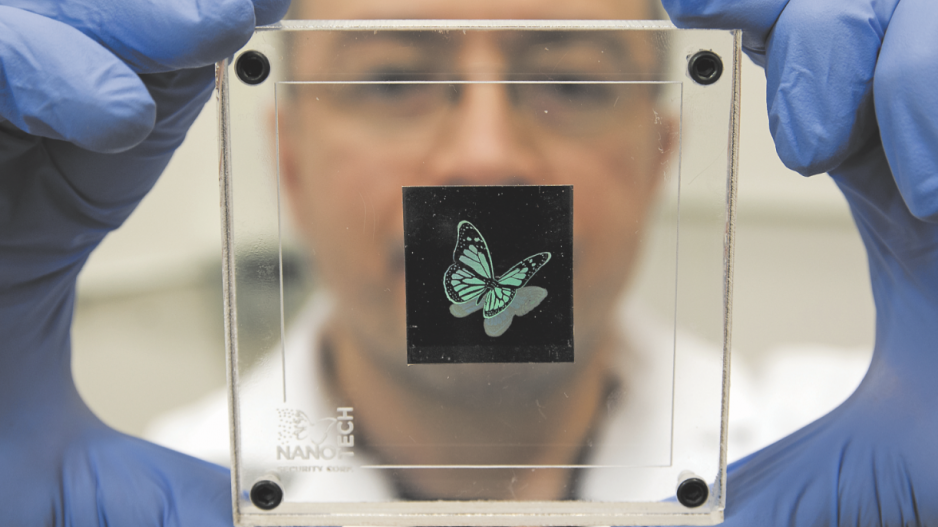Call it the butterfly effect.
While examining ways to make banknotes even more difficult to counterfeit, a Simon Fraser University (SFU) researcher took inspiration from the optical properties in the blue morpho butterfly’s iridescent wings.
Nanotech Security (TSX-V:NTS), an SFU spinoff, has developed technology that creates images on banknotes as natural light hits a grid of tiny – or nano-sized – holes on the bills.
The effect is similar to how the blue morpho’s wings interact with light – a feature not seen on any bills in circulation.
While some global firms are investing in fluorescent dyes and magnetic strips to meet market demand, no other company has gone the route of Nanotech.
“It’s very difficult to do; it’s very costly to get in the business,” Nanotech chief development officer Igi LeRoux said. “It’s not very highly competitive, but then the market [for nanotechnology] is not all that huge.”
He said that’s expected to change when the security features “hit the streets” in the coming years. For now, much of Nanotech’s recent growth has been coming from its legacy business.
Colour-shifting optical film has been the industry standard for banknote security since the 1990s. Depending on the angle of view, colours change on security features printed on bills in a way that the average person can recognize.
Because the nanotechnology has yet to be fully commercialized, the optical film side of the business is growing the most.
Purchase orders “in the low seven digits” from three international customers were finalized in February, according to the company.
And increased demand for the optical film products prompted Nanotech to add a second shift at its Quebec cellulose facility, which was acquired – along with the legacy business – from North Vancouver’s Fortress Paper (TSX:FTP) in August.
Fortress Paper CEO Chad Wasilenkoff said when discussions began over the sale of Fortress Optical Features (FOF) he was immediately drawn to Nanotech’s butterfly technology.
“Getting a brand-new security feature that has not been used anywhere before … [banks] are just not willing to take a chance on new things in general when it comes to banknotes,” he told Business in Vancouver.
“It will take a little while to come to fruition, but we think putting these two entities [Nanotech and FOF] together will definitely fast-track that.”
Counterfeiting hit its most recent peak in 2004, when 470 fake notes per million were detected across the country, according to a 2011 Bank of Canada (BoC) study.
The BoC developed and used the FOF technology until 2010, when counterfeit notes dropped to 35 per million.
Wasilenkoff, whose company operates another banknote security firm in Switzerland, said he was happy with the return on investment after Fortress bought the BoC assets for $750,000 and sold them to Nanotech three years later for $17.5 million.
“We were able to find a solution that was really synergistic for both companies,” he said, adding that Fortress will receive preferential treatment on new security features Nanotech develops.
Meanwhile, now that FOF is no longer competing with a sister company, LeRoux said there has been “quite a resurgence” in the legacy business’ technology.
Although at this stage the nano-technology and optical film sides of the business are slightly separate, he said there’s “a planned convergence of these [products] very soon.”
LeRoux added that acquiring the legacy business was necessary if the nanotechnology was to be taken seriously in an industry that greets upstart companies with skepticism.
“We have an established network, we have an established market base, we have an existing product and – most importantly – we have an existing reputation in the industry.”




